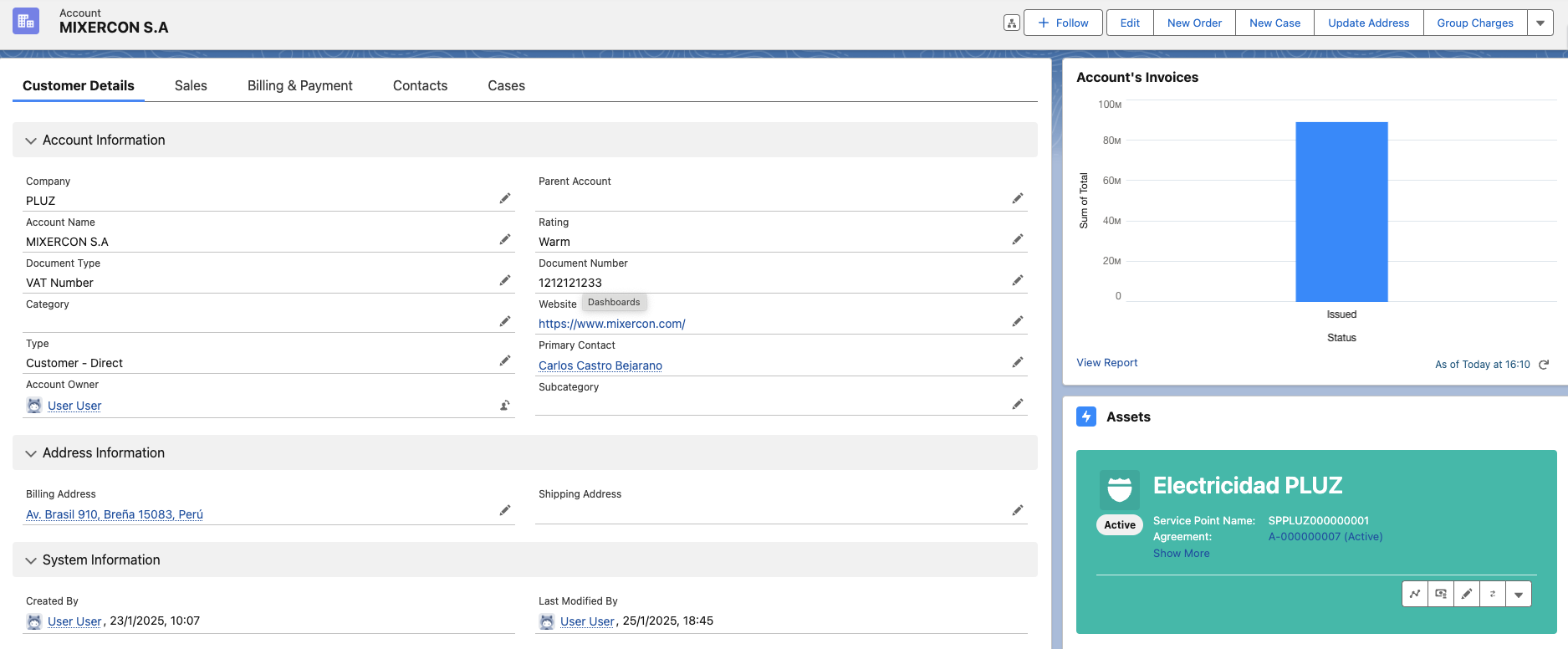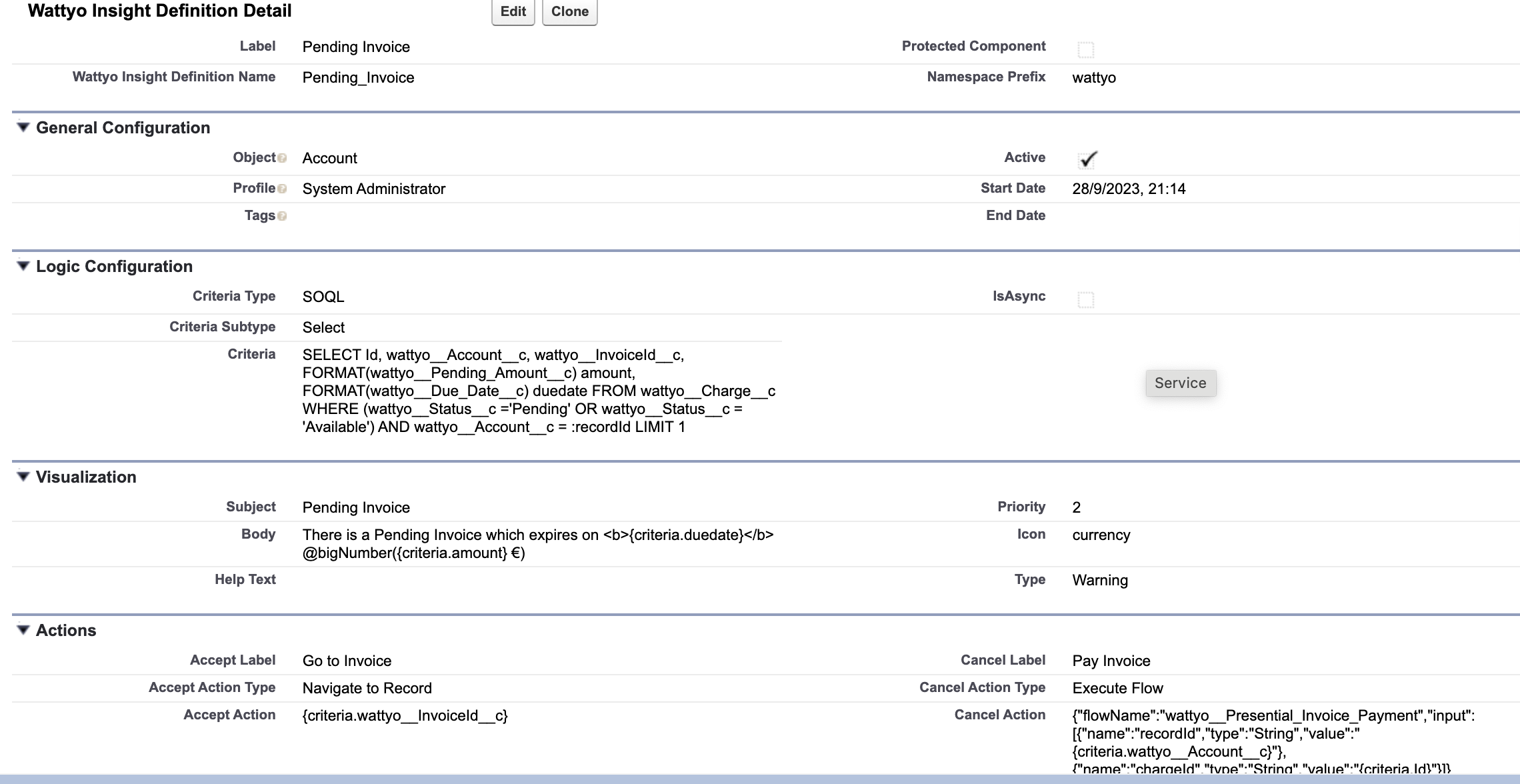Customer and Contact Management
This process focuses on the comprehensive management of customers and contacts, ensuring a detailed understanding of their needs while complying with privacy regulations
Comprehensive Customer View
It provides a 360-degree view of customer information in a single location, facilitating data-driven decision-making.
By integrating all end-to-end (E2E) customer management information into the same platform and leveraging Salesforce’s capabilities, Wattyo delivers a comprehensive customer view, consolidating all relevant information, customer notifications, and quick access to the most common operations based on the customer’s situation and recent activity.

Alerts and Quick Access
Wattyo Insights is a component specifically designed to support customer interaction across all processes.
Generates advanced alerts and notifications regarding customer behavior without requiring programming knowledge.
Identifies opportunities to improve customer interactions.
Allows businesses to customize notifications and quick-access features according to their specific needs and business objectives.

For example, in the image, three customer notifications are displayed, one of which is a “Warning” indicating that the customer has an outstanding invoice.

Next image shows the parametrisation of “Pending Invoice” warning alert using Wattyo Insights.
To learn more about configuring Wattyo Insights, visit Wattyo Insights
Customer Registration and Onboarding
The first step in customer data management is registering a new customer in the company’s database. This can be done through various channels integrated with Salesforce, including:
- Phone calls
- Interactions at sales points
- Business representatives
- Virtual office
With Wattyo, Salesforce capabilities provide a preconfigured customer management solution tailored to the utilities sector, which can be modified to meet each project’s requirements.
Key Customer Registration Fields:
| Field | Description |
|---|---|
| Personal Data | Full name, date of birth, gender, marital status. |
| Contact Information | Phone number, email, physical address. |
| Commercial Information | Customer type (B2B or B2C), company (if applicable), sector, job title. |
| Preferences | Interests, preferred communication channels. |
| Additional Data | GDPR and marketing consents. |
Customer Data Update and Maintenance
Customer information must always be kept accurate and up-to-date. The system should allow easy editing and updating of customer data.
Examples of Data Updates:
- Address, phone number, and email changes.
- Communication preference updates.
- Organizational changes within the customer’s company or group structure.
Customer Segmentation
Customer segmentation classifies users into groups based on various criteria to improve service personalization and marketing campaigns.
| Common Segmentation Criteria: | Criteria | Description |
|---|---|---|
| Demographic | Age, gender, geographic location. | |
| Behavioral | Purchase frequency, type of acquired products. | |
| Customer Value | VIP customers, returning customers, new customers. | |
| Interests and Preferences | Product category interests, preferred communication channels. |
Customer Activity Tracking
Tracking customer activity helps anticipate needs and offer relevant content or promotions.
Data Analyzed in Customer Tracking:
- Product purchase history.
- Customer service interactions.
- Complaints and support request history.
- Billing and payment status.
Contact Management
This ensures structured administration of customer contacts, keeping information updated and accessible for service and sales teams.
Allows multiple contact persons to be associated with a single customer.
Authorized Contact Management
Ensures that customers with special permissions are managed appropriately.
Defines rules for accessing sensitive information, allowing authorized users to act on behalf of the customer under documented authorization.
Provides easy access for agents and virtual offices to manage authorizations correctly.
Individual Management / GDPR Compliance
Ensures that the collection, storage, and processing of personal data comply with the General Data Protection Regulation (GDPR).
Provides tools for handling requests for data access, correction, and deletion, ensuring customer data privacy.
Interaction History
Records all customer interactions with the company, including calls, emails, purchases, and service inquiries.
Helps analyze trends in customer behavior and improve personalized service delivery.
If Service Cloud is implemented, this feature can be integrated with “Case” salesforce Object to easy integration with other Salesforce Clouds.








